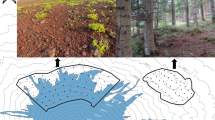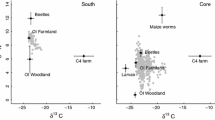Abstract
Resource partitioning is the basis of the coexistence of sympatric species and has therefore received much attention in ecological studies. However, how variation in environmental conditions (and particularly natural variation in resource availability) can influence resource partitioning in free-ranging animals is not well understood. In the present study, we addressed the hypothesis that natural changes in the availability of food resources affect food partitioning between sympatric species. To do so, we examined temporal changes in the plasma isotopic signature (δ15N and δ13C) of syntopic Lincoln’s sparrows Melospiza lincolnii and white-crowned sparrows Zonotrichia leucophrys, in parallel with seasonal changes in habitat maturity and food availability from spring to early summer. We found no apparent trophic segregation between Lincoln’s and white-crowned sparrows when resources were scarce in spring. But, interestingly, as resource availability and the number of breeding birds increased, Lincoln’s sparrows showed lower δ15N values than white-crowned sparrows, as they consumed more prey from lower trophic levels and less prey from higher trophic levels. This feeding divergence between sympatric species may be explained (1) by a change in foraging preferences and opportunities for Lincoln’s sparrows and (2) by the abundance of competitors that increased faster than resources, thus promoting interspecific competition and trophic segregation. These results provide clear evidence that trophic segregation is dynamically tied to variation in environmental conditions, which are therefore fundamental to consider when examining resource partitioning between co-existing species.






Similar content being viewed by others
References
Ammon EM (1995) Lincoln’s Sparrow (Melospiza lincolnii). In: Poole A (ed) The Birds of North America Online Ithaca: Cornell Lab of Ornithology; Retrieved from the Birds of North America Online:http://bna.birds.cornell.edu/bna/species/191
Arnold KE, Ramsay SL, Donaldson C, Adam A (2007) Parental prey selection affects risk-taking behaviour and spatial learning in avian offspring. Proc R Soc Lond B 274:2563–2569. doi:10.1098/rspb.2007.0687
Bearhop S, Phillips RA, McGill R, Cherel Y, Dawson DA, Croxall JP (2006) Stable isotopes indicate sex-specific and long-term individual foraging specialization in diving seabirds. Mar Ecol Prog Ser 311:157–164
Butler C (2003) The disproportionate effect of global warming on the arrival dates of short distance migratory birds in North America. Ibis 145:484–495. doi:10.1046/j.1474-919X.2003.00193.x
Carleton SA, Kelly L, Anderson-Sprecher R, Martínez del Rio C (2008) Should we use one-, or multi-compartment models to describe 13C incorporation into animal tissues? Rapid Commun Mass Spectrom 22:3008–3014. doi:10.1002/rcm.3691
Caut S, Angulo E, Courchant F (2009) Variation in discrimination factors (∆15N and ∆13C): the effect of diet isotopic values and applications for diet reconstruction. J Appl Ecol 46:443–453. doi:10.1111/j.1365-2664.2009.01620.x
Chase JM, Abrams PA, Grover JP, Diehl S, Chesson P, Holt RD, Richards SA, Nisbet RM, Case TJ (2002) The interaction between predation and competition: a review and synthesis. Ecol Lett 5:302–315
Chesson P, Huntly N (1997) The roles of harsh and fluctuating conditions in the dynamics of ecological communities. Am Nat 150:519–553
Chilton G, Baker MC, Barrentine CD, Cunningham MA (1995) White-crowned sparrow (Zonotrichia leucophrys). In: Poole A (ed) The Birds of North America Online. Ithaca: Cornell Lab of Ornithology; Retrieved from the Birds of North America Online: http://bna.birds.cornell.edu/bna/species/183
Dalerum F, Angerbjörn A (2005) Resolving temporal variation in vertebrate diets using naturally occurring stable isotopes. Oecologia 144:647–658. doi:10.1007/s00442-005-0118-0
Dhondt AA (2010) Effects of competition on great and blue tit reproduction: intensity and importance in relation to habitat quality. J Anim Ecol 79:257–265. doi:10.1111/j.1365-2656.2009.01624.x
Forero MG, González-Solís J, Hobson KA, Doncazar JA, Bertellotti M, Blanco G, Bortolotti GR (2005) Stable isotopes reveal trophic segregation by sex and age in the southern giant petrel in two different food webs. Mar Ecol Prog Ser 296:107–113. doi:10.3354/meps296107
Helle G, Schleser GH (2004) Beyond CO2-fixation by Rubisco—an interpretation of 13C/12C variations in tree rings from novel intra-seasonal studies on broad-leaf trees. Plant Cell Environ 27:367–380. doi:10.1111/j.0016-8025.2003.01159.x
Horn HS (1966) Measurement of overlap in comparative ecological studies. Am Nat 100:419–424
Inger R, Bearhop S (2008) Applications of stable isotope analyses to avian ecology. Ibis 150:447–461. doi:10.1111/j.1474-919X.2008.00839.x
Kelly JF (2000) Stable isotopes of carbon and nitrogen in the study of avian and mammalian trophic ecology. Can J Zool 78:1–27
Leyequién E, Boer WF, Cleef A (2007) Influence of body size on coexistence of bird species. Ecol Res 22:735–741. doi:10.1007/s11284-006-0311-6
Li SG, Tsujimura M, Sugimoto A, Davaa G, Oyunbaatar D, Sugita M (2007) Temporal variation of δ 13C of larch leaves from a montane boreal forest in Mongolia. Trees 21:479–490. doi:10.1007/s00468-007-0142-2
Morton ML (1967) Diurnal feeding patterns in white-crowned sparrows, Zonotrichia leucophrys gambelii. Condor 69:491–512
Newsome SD, Martinez del Rio C, Bearhop S, Phillips DL (2007) A niche for isotopic ecology. Front Ecol Environ 5:429–436. doi:10.1890/060150.1
O’Leary MH (1981) Carbon isotope fractionation in plants. Phytochemistry 20:553–567
Parnell A, Inger R, Bearhop S, Jackson AL (2010) Source partitioning using stable isotopes: coping with too much variation. PLoS ONE 5:e9672
Peach WJ, Vincent KE, Fowler JA, Grice PV (2008) Reproductive success of house sparrows along an urban gradient. Anim Conserv 11:493–503. doi:10.1111/j.1469-1795.2008.00209.x
Peiman KS, Robinson BW (2010) Ecology and evolution of resource-related heterospecific aggression. Q Rev Biol 85:133–158. doi:10.1086/652374
Podlesak DW, McWilliams SR, Hatch KA (2005) Stable isotopes in breath, blood, feces and feathers can indicate intra-individual changes in the diet of migratory songbirds. Oecologia 142:501–510. doi:10.1007/s00442-004-1737-6
Post DM, Layman CA, Albrey Arrington D, Takimoto G, Quattrochi J, Montaña CG (2007) Getting to the fat of the matter: models, methods and assumptions for dealing with lipids in stable isotope analyses. Oecologia 152:179–189. doi:10.1007/s00442-006-0630-x
Raley CM, Anderson SA (1990) Availability and use of arthropods food resources by Wilson’s warblers and Lincoln’s sparrows in southeastern Wyoming. Condor 92:141–150
Schoener TW (1974) Resource partitioning in ecological communities. Science 185:27–39
Sears J, Hatch SA, O’Brien DM (2009) Disentangling effects of growth and nutritional status on seabird stable isotope ratios. Oecologia 159:41–48. doi:10.1007/s00442-008-1199-3
Sockman KW (2008) Ovulation order mediates a trade-off between pre-hatching and post-hatching viability in an altricial bird. PLoS ONE 3:e1785. doi:10.1371/journal.pone.0001785
Sockman KW (2009) Annual variation in vocal performance and its relationship with bill morphology in Lincoln’s sparrows, Melospiza lincolnii. Anim Behav 77:663–671. doi:10.1016/j.anbehav.2008.11.016
Tsahar E, Wolf N, Izhaki I, Arad Z, Martínez del Rio C (2008) Dietary protein influences the rate of 15N incorporation in blood cells and plasma of yellow-vented bulbuls (Pycnonotus xanthopygos). J Exp Biol 211:459–465. doi:10.1242/jeb.013219
Villafuerte R, Negro JJ (1998) Digital imaging for colour measurement in ecological research. Ecol Lett 1:151–154
Zeng X, Lu X (2009) Interspecific dominance and asymmetric competition with respect to nesting habitats between two snowfinch species in a high-altitude extreme environment. Ecol Res 24:607–616. doi:10.1007/s11284-008-0530-0
Acknowledgments
We would like to thank Emma Johnson, Caroline Jordan, Alex Rohtla and Daniel Bobrowski for their great help in the field. We are also grateful to Drs Amber Rice, André A. Dhondt, Martin L. Morton, and two anonymous reviewers for their useful comments on this manuscript. The US Department of the Interior, Geological Service (permit 23370), the US Fish and Wildlife Service (permit MB099926-0), the US Department of Agriculture Forest Service (authorization COL584), the State of Colorado Department of Natural Resources Division of Wildlife (license 10TRb1056), the Town of Silverton, Colorado, USA, and the Institutional Animal Care and Use Committee of the University of North Carolina at Chapel Hill (protocol 08-089.0-B) each granted permission to conduct the procedures described in this study. This research was supported in part by NINDS R01 NS055125 to K.W.S.
Author information
Authors and Affiliations
Corresponding author
Additional information
Communicated by Peggy Ostrom.
Rights and permissions
About this article
Cite this article
Beaulieu, M., Sockman, K.W. One meadow for two sparrows: resource partitioning in a high elevation habitat. Oecologia 170, 529–540 (2012). https://doi.org/10.1007/s00442-012-2327-7
Received:
Accepted:
Published:
Issue Date:
DOI: https://doi.org/10.1007/s00442-012-2327-7




